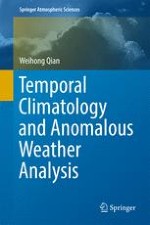2017 | Buch
Über dieses Buch
By breaking down atmospheric variables into temporal climatologies and anomalies, this book demonstrates that all weather extremes and climatic events are directly associated with the anomaly component of atmospheric motion. We can use the anomaly-based synoptic chart and dynamical parameters to objectively describe these extremes and events. The conception and differences of weather, climate and general circulation tend to confuse us, because there are no clear physical definitions available for them.
Weather extremes such as heat waves, cold surges, freezing rains, heavy rains, severe drought, unusual storm tracks, and tornados are common on our planet’s surface. Climatic events such as Arctic warming and declining sea ice have become hot topics in recent years. An approach based on breaking down total variables into temporal climatologies and anomalies can be used to identify general circulation, analyze climatic anomalies and forecast weather extremes. Accordingly, this book will appeal to students, teachers and forecasters in the field of weather and climate alike.
Anzeige
